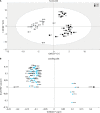Systemic alterations in plasma proteins from women with chronic widespread pain compared to healthy controls: a proteomic study
- PMID: 28435317
- PMCID: PMC5388344
- DOI: 10.2147/JPR.S128597
Systemic alterations in plasma proteins from women with chronic widespread pain compared to healthy controls: a proteomic study
Abstract
Chronic widespread pain (CWP) is a complex pain condition that is difficult to treat. The prevalence of CWP approximates ~10% of the general population, with higher prevalence in women. Lack of understanding of molecular mechanisms has been a challenge for diagnosis and treatment of chronic pain. The aim of this study was to explore the systemic protein changes in CWP compared to those in healthy controls (CON). By applying 2-dimensional gel electrophoresis, we analyzed the protein pattern of plasma samples from women with CWP (n=16) and healthy women (n=23). The proteomic data were analyzed using multivariate statistical models, and altered proteins were identified using mass spectrometry. The proteome analysis was further validated by gel-free Western blot. Multivariate statistical data analysis of quantified proteins revealed 22 altered proteins in women with CWP, compared to CON group. Many of the identified proteins are previously known to be involved in different parts of the complement system and metabolic and inflammatory processes, e.g., complement factor B, vitamin D-binding protein, ceruloplasmin, transthyretin and alpha-2-HS-glycoprotein. These results indicate that important systemic protein differences exist between women with CWP and healthy women. Further, this study illustrates the potential use of proteomics to detect biomarkers that may provide new insights into the molecular mechanism(s) of chronic pain. However, further larger investigations are required in order to confirm these findings before it will be possible to identify proteins as potential pain biomarkers for clinical use.
Keywords: GC protein; biomarker; complement system; inflammation; painomics.
Conflict of interest statement
Disclosure The authors report no conflicts of interest in this work.
Figures



Similar articles
-
Plasma Protein Pattern Correlates With Pain Intensity and Psychological Distress in Women With Chronic Widespread Pain.Front Psychol. 2018 Nov 29;9:2400. doi: 10.3389/fpsyg.2018.02400. eCollection 2018. Front Psychol. 2018. PMID: 30555396 Free PMC article.
-
Thermal Pain Thresholds Are Significantly Associated with Plasma Proteins of the Immune System in Chronic Widespread Pain-An Exploratory Pilot Study Using Multivariate and Network Analyses.J Clin Med. 2021 Aug 18;10(16):3652. doi: 10.3390/jcm10163652. J Clin Med. 2021. PMID: 34441948 Free PMC article.
-
Signs of ongoing inflammation in female patients with chronic widespread pain: A multivariate, explorative, cross-sectional study of blood samples.Medicine (Baltimore). 2017 Mar;96(9):e6130. doi: 10.1097/MD.0000000000006130. Medicine (Baltimore). 2017. PMID: 28248866 Free PMC article.
-
Genetic and epigenetic epidemiology of chronic widespread pain.J Pain Res. 2017 Aug 24;10:2021-2029. doi: 10.2147/JPR.S143869. eCollection 2017. J Pain Res. 2017. PMID: 28894385 Free PMC article. Review.
-
Is Serum Hypovitaminosis D Associated with Chronic Widespread Pain Including Fibromyalgia? A Meta-analysis of Observational Studies.Pain Physician. 2015 Sep-Oct;18(5):E877-87. Pain Physician. 2015. PMID: 26431141 Review.
Cited by
-
Fibromyalgia: Associations Between Fat Infiltration, Physical Capacity, and Clinical Variables.J Pain Res. 2022 Aug 27;15:2517-2535. doi: 10.2147/JPR.S376590. eCollection 2022. J Pain Res. 2022. PMID: 36061487 Free PMC article.
-
Diurnal variation of inflammatory plasma proteins involved in pain.Pain Rep. 2019 Aug 13;4(5):e776. doi: 10.1097/PR9.0000000000000776. eCollection 2019 Sep-Oct. Pain Rep. 2019. PMID: 31875183 Free PMC article.
-
Evidence of Mitochondrial Dysfunction in Fibromyalgia: Deviating Muscle Energy Metabolism Detected Using Microdialysis and Magnetic Resonance.J Clin Med. 2020 Oct 31;9(11):3527. doi: 10.3390/jcm9113527. J Clin Med. 2020. PMID: 33142767 Free PMC article.
-
Differences in plasma lipoprotein profiles between patients with chronic peripheral neuropathic pain and healthy controls: an exploratory pilot study.Pain Rep. 2022 Sep 22;7(5):e1036. doi: 10.1097/PR9.0000000000001036. eCollection 2022 Sep-Oct. Pain Rep. 2022. PMID: 36203648 Free PMC article.
-
The Vastus Lateralis Muscle Interstitium Proteome Changes after an Acute Nociception in Patients with Fibromyalgia Compared to Healthy Subjects-A Microdialysis Study.Biomedicines. 2023 Jan 13;11(1):206. doi: 10.3390/biomedicines11010206. Biomedicines. 2023. PMID: 36672714 Free PMC article.
References
-
- Cimmino MA, Ferrone C, Cutolo M. Epidemiology of chronic musculoskeletal pain. Best Pract Res Clin Rheumatol. 2011;25(2):173–183. - PubMed
-
- Bergman S, Herrstrom P, Hogstrom K, Petersson IF, Svensson B, Jacobsson LT. Chronic musculoskeletal pain, prevalence rates, and sociodemographic associations in a Swedish population study. J Rheumatol. 2001;28(6):1369–1377. - PubMed
-
- Lindell L, Bergman S, Petersson IF, Jacobsson LT, Herrstrom P. Prevalence of fibromyalgia and chronic widespread pain. Scand J Prim Health Care. 2000;18(3):149–153. - PubMed
LinkOut - more resources
Full Text Sources
Other Literature Sources
Research Materials
Miscellaneous

